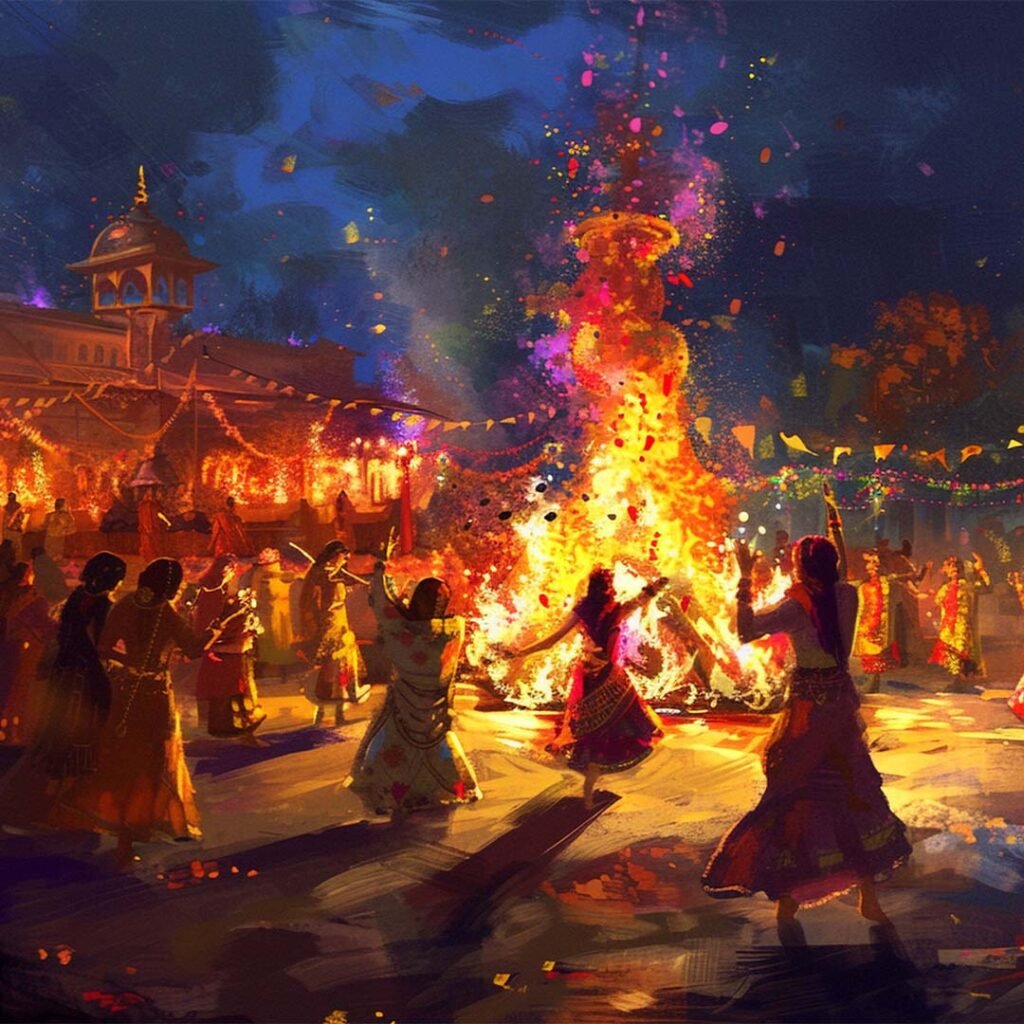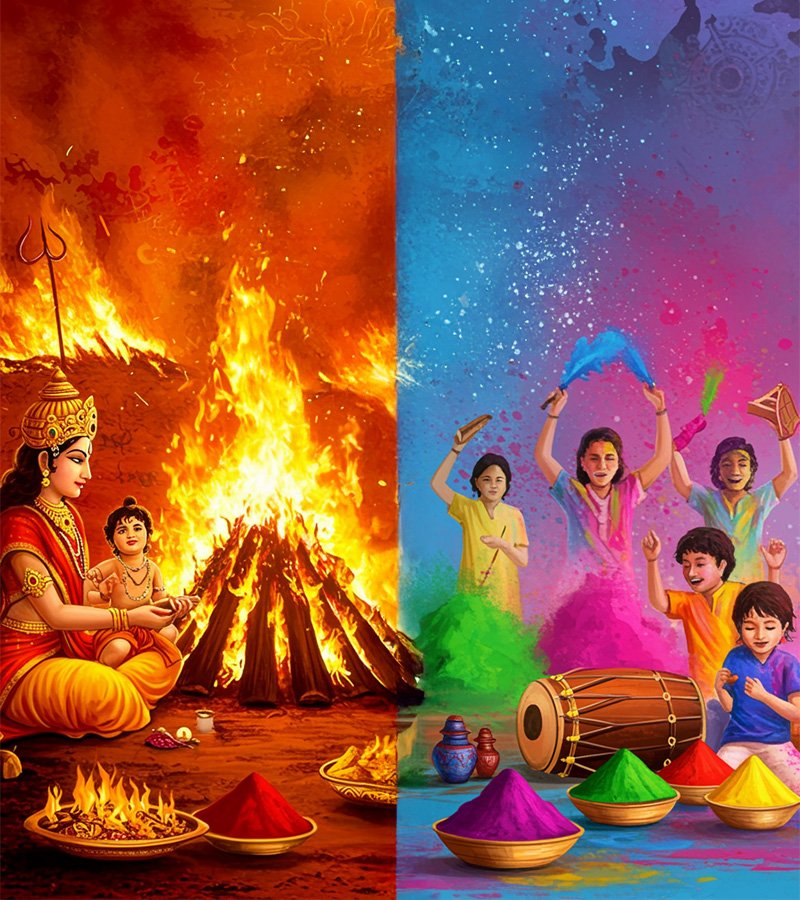

Holika Dahan 2025: Date, Time, Rituals & Spiritual Significance
Holika Dahan is a sacred Hindu ritual celebrated on Phalgun Purnima, marking the victory of good over evil. It symbolizes the burning of negativity, inspired by the story of Holika and Prahlad. People gather to light a bonfire, perform puja, offer grains, and seek blessings for protection, prosperity, and happiness. The next day, colors are played on Holi, spreading joy and unity.
God (Deity Worshiped)
- Lord Vishnu: Worshiped for protecting Prahlad and destroying evil (Holika).
- Prahlad: Symbol of devotion.
- Holika: Represents the destruction of evil.
Purpose of Pooja
- Good Over Evil: Celebrates the victory of Prahlad’s devotion (good) over Holika’s evil.
- Purification: Burning the bonfire symbolizes the destruction of negative energies.
- Protection: A reminder of divine protection through devotion and faith.
Best Time
- Date: Evening of Phalguna Purnima, the full moon day before Holi.
- Timing: Ideal between 7:00 PM and 9:00 PM.
Key Rituals
- Bonfire: A large bonfire is lit, often with a Holika effigy, to signify the burning of evil.
- Prayers and Offerings: Devotees offer prayers, grains, and walk around the fire.
- Ashes: The ashes are collected for blessings and purification.
- Celebration: Songs, dances, and festive activities around the bonfire.
Step-by-Step Holika Dahan Vidhi
Purify Yourself and the Area
- Take a bath and wear clean clothes before starting the pooja.
- Clean the area where Holika Dahan will take place.
- Sprinkle Gangajal (holy water) around to purify the surroundings.
Prepare the Holika Pyre
- Arrange wood logs, dried cow dung cakes (Uple), and grass in a bonfire shape.
- Place an idol or image of Holika and Prahlad in the center (Holika made of combustible materials).
- Tie a sacred Moli (red thread) around the Holika.
Perform the Pooja
- Light a diya and incense sticks.
- Apply Haldi (turmeric), Kumkum (vermilion), and Akshat (rice grains) to the Holika.
- Offer flowers, garlands, and raw turmeric to the fire.
- Chant Holika Dahan Mantras for protection from negativity.
Offer Pooja Samagri
- Offer coconut, wheat grains, jaggery, black sesame seeds, mustard seeds, and camphor into the fire.
- Roast chana (gram) and wheat grains, symbolizing prosperity.
- Offer batasha, mishri, and sweets as prasad.
Light the Holika Fire
- An elder or priest should light the Holika fire while chanting mantras.
- Pray for the destruction of negativity, fear, and evil forces in life.
Take Parikrama (Circumambulation)
- Walk around the fire three or seven times, offering water and chanting prayers.
- Women, especially married ones, seek blessings for their family’s well-being.
Distribute Prasad and Ash
- After the fire burns down, collect its holy ash (bhasma) and apply it to the forehead for protection.
- Distribute roasted chana, wheat grains, and sweets as Prasad to family and neighbors.
Important Rules & Precautions
- Perform the ritual during Pradosh Kaal (evening time) as per the muhurta.
- Avoid using plastics, chemicals, or harmful items in the fire.
- Pregnant women and infants should maintain a safe distance.
- Ensure that the fire is completely extinguished after the ritual.
- The next day, use the ashes for spiritual protection or mix them into plants for positivity.
Pooja Items for Holika Dahan:
- Cow dung cakes (Uple) – For the Holika pyre
- Wood logs – For the bonfire
- Ghee & Mustard oil – For lighting the Holika
- Camphor (Kapoor) – For purification
- Incense sticks (Agarbatti) – For fragrance & positivity
- Cotton wicks (Batti) – For the diya
- Sacred thread (Moli) – For tying around Holika
- Turmeric (Haldi) & Kumkum – For tilak
- Rice (Akshat) – For offering
- Flowers & Garland – For decoration
- Coconut – For offering into the fire
- Jaggery (Gur) & Sugar – For sweetness in life
- Whole wheat grains (Gehun ke Dane) – To offer to Holika
- Gram (Chana) – To roast in the fire as Prasad
- Betel leaves & betel nuts (Paan & Supari) – For offering
- Raw Turmeric (Kachchi Haldi) – For blessings
Prasad Items for Holika Dahan:
- Roasted Chana (Black Gram) – The main offering
- Coconut (Nariyal) – Offered and then distributed as Prasad
- Jaggery (Gur) – Symbolizing sweetness in relationships
- Sugar crystals (Mishri) – For blessings and positivity
- Batasha & Gatta – Traditional sweet offerings
- Puffed rice (Lai or Murmura) – For prosperity
- Dry fruits – For auspiciousness
- Sweet flour-based items – Depending on regional traditions
Mantra
Holika Dahan Mantra (For Worship & Protection):
ॐ होलिकायै नमः
Mantra While Offering Prasad to Holika:
अहकूटा भयत्रस्तं पापं दहति तत्क्षणात्।
गृहं क्लेशं च शोकं च महादेवि नमोऽस्तु ते॥
Aarti
ॐ जय होलिका माता, जय होलिका माता।
तुमको निशदिन सेवत, हर विष्णु विधाता॥
ॐ जय होलिका माता…
जो श्रद्धा से ध्यावत, मनवांछित फल पावत।
दरश तुम्हारो पावत, दुख विनाशी जावत॥
ॐ जय होलिका माता…
तुम हो शक्ति अविनाशी, भक्तन की हो आस।
चरण शरण जो आवे, सो पावे सुखरास॥
ॐ जय होलिका माता…
धूप दीप फल मेवा, स्वीकृ करो माता।
ज्ञान बुद्धि बल देना, भक्ति करो दाता॥
ॐ जय होलिका माता…
होलिका माता की आरती, जो कोई नर गावे।
कहत शिवानंद स्वामी, सुख-संपत्ति पावे॥
ॐ जय होलिका माता, जय होलिका माता।
तुमको निशदिन सेवत, हर विष्णु विधाता॥
Story of Holika Dahan
Hiranyakashipu, a powerful demon king, wanted to be worshiped as a god. However, his own son, Prahlad, was a devoted follower of Lord Vishnu. This angered Hiranyakashipu, and despite many attempts to stop Prahlad’s devotion, the boy remained steadfast in his faith.
Frustrated, Hiranyakashipu sought help from his sister Holika, who had a divine boon making her immune to fire. She tricked Prahlad into sitting on her lap inside a blazing fire, thinking he would be burned while she remained unharmed.
However, by the grace of Lord Vishnu, Holika’s boon failed because she used it for evil. She was burned to ashes, while Prahlad emerged unharmed, protected by his unwavering faith.
Significance of Holika Dahan
The burning of Holika represents the destruction of evil, arrogance, and negativity, while Prahlad’s survival signifies the power of devotion, faith, and righteousness.
On the night of Holika Dahan, people light bonfires to symbolize the burning of evil and pray for happiness, prosperity, and protection. The next day, Holi is celebrated with colors, marking joy, love, and new beginnings.
Holika Dahan reminds us that truth and devotion always triumph over wickedness.
How Holika Dahan is related to Holi?
Holika Dahan and Holi are deeply connected, symbolizing the transition from darkness to light and the triumph of good over evil. Holika Dahan, observed on Phalgun Purnima, represents the burning away of negativity, inspired by the legend of Prahlad and Holika. The ritual bonfire purifies the surroundings and marks a fresh beginning. The next day, Holi, the festival of colors, spreads joy, unity, and renewal, celebrating the arrival of spring. Together, these festivals signify letting go of past burdens and embracing happiness, love, and new opportunities.

Fun & Lesser-Known Facts About Holika Dahan
Holika Dahan is more than just a fire ritual; it’s a spiritual cleansing process that prepares us for the vibrant celebrations of Holi the next day! Holika Dahan is not just a ritual but a festival rich in traditions, beliefs, and regional variations. Here are some fascinating and lesser-known facts that make this festival even more special:
Holika’s Sacred Fire for Protection
In Rajasthan and Madhya Pradesh, people take embers from the Holika Dahan fire to their homes, believing it wards off evil eyes and negative energies.
Lathmar Holi – A Unique Celebration
In Barsana and Nandgaon, Holi is celebrated in a unique way with Lathmar Holi, where women playfully hit men with sticks, reenacting the divine play of Radha and Krishna.
The Tradition of Tilak from Ashes
Earlier, devotees used to apply the ashes of Holika Dahan as a tilak on their foreheads, believing it brings good luck and spiritual protection.
Burning Bad Habits in Holika
Many people write down their bad habits, fears, and negative thoughts on paper and burn them in the Holika fire, symbolizing self-purification and a fresh start.
The Significance of Offering Coconut
Throwing a coconut into the fire represents breaking one's ego and surrendering to Lord Vishnu, seeking divine blessings and humility.

